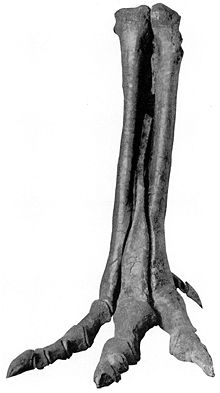獨龍屬
| 獨龍屬 化石時期:白堊紀後期,
| |
|---|---|

| |
| 根據正模標本推估出的獨龍體型 | |
| 科學分類 | |
| 界: | 動物界 Animalia |
| 門: | 脊索動物門 Chordata |
| 綱: | 蜥形綱 Sauropsida |
| 總目: | 恐龍總目 Dinosauria |
| 目: | 蜥臀目 Saurischia |
| 亞目: | 獸腳亞目 Theropoda |
| 演化支: | 新獸腳類 Neotheropoda |
| 演化支: | 鳥吻類 Averostra |
| 演化支: | 堅尾龍類 Tetanurae |
| 演化支: | 俄里翁龍類 Orionides |
| 演化支: | 鳥獸腳類 Avetheropoda |
| 演化支: | 虛骨龍類 Coelurosauria |
| 演化支: | 暴盜龍類 Tyrannoraptora |
| 總科: | †暴龍總科 Tyrannosauroidea |
| 演化支: | †泛暴龍類 Pantyrannosauria |
| 演化支: | †真暴龍類 Eutyrannosauria |
| 屬: | †獨龍屬 Alectrosaurus Gilmore, 1933 |
| 模式種 | |
| 奧氏獨龍 Alectrosaurus olseni Gilmore, 1933
| |
獨龍屬(屬名:Alectrosaurus),又名獨身龍、鷹龍、阿萊龍或阿萊克特龍,是暴龍超科恐龍的一個屬,生存於上白堊紀的中國內蒙古。獨龍是雙足的肉食性恐龍,與其他大型近親(如暴龍)的外形相似。獨龍的體型比較小型,只有約5米長。
獨龍的化石是在1923年發現。在1933年,美國古生物學家查爾斯·懷特尼·吉爾摩爾(Charles W. Gilmore)將這個化石敘述、命名。獨龍目前只有一個種,稱為奧氏獨龍(學名A. olseni,或譯奧氏鷹龍)。獨龍的屬名意為「單獨的蜥蜴」,是從希臘文的 αλέκτρος/alektros「不成對的;沒有伴的」與 σαῦρος/sauros「蜥蜴」而來。因為在發現的時候,牠並不像其他的亞洲肉食性恐龍。種名則是紀念發現此標本的喬治·奧爾森(George Olsen)。
在2001年,布魯斯·羅斯柴爾德(Bruce Rothschild)等人發表一份獸腳類恐龍的壓力性骨折研究。他們研究23個獨龍的腳掌骨骼,沒有發現壓力性骨折的跡象[1]。
發現歷史
[編輯]
獨龍的正模標本(AMNH 6554)是一個後肢,發現於中國內蒙古的二連諾爾地層[2]。獨龍的前肢化石,之後被發現錯誤鑑定為鐮刀龍類的化石[3]。
該地層的年代並不清楚,但一般估計是在白堊紀的坎帕階,距今8300萬-7400萬年前。
有很多其他的標本被認為屬於獨龍,包括一些後肢、頭顱骨及肩膀骨頭。這些化石都是發現於蒙古國的巴彥思楞組(Bayan Shireh Formation),但這個地層的年代也無法確定[4]。它可能追溯至坎帕階早期,但近年研究估計指它是從森諾曼階至桑托階[5]。二連諾爾地層及巴彥思楞組的恐龍群都很相似。但是,一個近年研究認為二連諾爾地層可能是由坎帕階至麥斯特裏希特階,與耐梅蓋特地層有所關連[6],如果研究屬實,很有可能在耐梅蓋特地層發現獨龍的化石。
此外,有更多部分骨骼發現於蒙古國、中國內蒙古[7]。但到在2007年為止,這些化石都沒有被描述、研究。
分類
[編輯]獨龍明顯是屬於暴龍超科,但由於其化石碎裂的緣故,很難確定獨龍在暴龍超科的分類關係、演化位置,某些分支系統學分析也將獨龍省略。一項研究發現在暴龍超科的演化樹中,獨龍位於小於8個簡約位置[8]。某些古生物學家主張奧氏獨龍是艾伯塔龍的一個種[9]。
獨龍最初被認為是有長手臂的獸腳亞目恐龍,但這是因為將慢龍下目的前臂當作是獨龍的所致[4][10]。雖然其脛骨與股骨的比例軷低,即這兩塊骨頭大少相當,而大部分暴龍超科恐龍的脛骨較長,但脛骨仍表示獨龍是一隻真正的暴龍超科恐龍。獨龍的腳掌與腳踝的長度,與脛骨的長度相近,如同其他暴龍超科;但其他暴龍超科的腳掌較長。
在巴彥思楞組發現的化石是否屬於獨龍屬,須要更多的研究證明。一個分支系統學分析顯示,這兩個標本可能不是同一種,但很可能是近親[3]。
參考資料
[編輯]- ^ Rothschild, B., Tanke, D. H., and Ford, T. L., 2001, Theropod stress fractures and tendon avulsions as a clue to activity: In: Mesozoic Vertebrate Life, edited by Tanke, D. H., and Carpenter, K., Indiana University Press, p. 331-336.
- ^ Gilmore, C.W. (1933). On the dinosaurian fauna of the Iren Dabasu Formation. Bulletin of the American Museum of Natural History 67:23-78.
- ^ 3.0 3.1 Holtz, T.R. (2001). The phylogeny and taxonomy of the Tyrannosauridae. In: Tanke, D.H., and Carpenter, K. (Eds.). Mesozoic Vertebrate Life. Indiana University Press:Bloomington, 64-83. ISBN 0-253-33907-3.
- ^ 4.0 4.1 Perle, A. (1977). [On the first finding of Alectrosaurus (Tyrannosauridae, Theropoda) in the Late Cretaceous of Mongolia.] Problemy Geologii Mongolii 3:104-113. [In Russian]
- ^ Hicks, J.F., Brinkman, D.L., Nichols, D.J., and Watabe, M. (1999). Paleomagnetic and palynological analyses of Albian to Santonian strata at Bayn Shireh, Burkhant, and Khuren Dukh, eastern Gobi Desert, Mongolia. Cretaceous Research 20(6): 829-850.
- ^ van Itterbeecka, J., Horne, D.J., Bultynck, P., and Vandenbergh, N. (2005). Stratigraphy and palaeoenvironment of the dinosaur-bearing Upper Cretaceous Iren Dabasu Formation, Inner Mongolia, People's Republic of China. Cretaceous Research 26:699-725.
- ^ Currie, P.J. (2001). Theropods from the Cretaceous of Mongolia. In: Benton, M.J., Shishkin, M.A., Unwin, D.M., and Kurochkin, E.N. (Eds.). The Age of Dinosaurs in Russia and Mongolia. Cambridge University Press:Cambridge, 434-455. ISBN 052154582X.
- ^ Holtz, T.R. (2004). Tyrannosauroidea. In: Weishampel, D.A., Dodson, P., and Osmólska, H. (Eds.). The Dinosauria (2nd Edition). University of California Press:Berkeley, 111-136. ISBN 0-520-24209-2.
- ^ "Albertosaurus." In: Dodson, Peter & Britt, Brooks & Carpenter, Kenneth & Forster, Catherine A. & Gillette, David D. & Norell, Mark A. & Olshevsky, George & Parrish, J. Michael & Weishampel, David B. The Age of Dinosaurs. Publications International, LTD. p. 106-107. ISBN 0-7853-0443-6.
- ^ Mader, B.J., and Bradley, R.L. (1989). A redescription and revised diagnosis of the syntypes of the Mongolian tyrannosaur Alectrosaurus olseni. Journal of Vertebrate Paleontology 9(1):41-55.















